Ecommerce strategies for success this 2020 holiday season

Ecommerce in 2020 is both an exciting and stressful place to be. As an IT or ecommerce manager, you're under tremendous pressure to make up for lost physical store sales and ramp up digital operations nearly overnight. In this blog, you'll get 4 concrete strategies leading retailers are using to capture sales this year, plus 5 tips to adapt your digital operations for unprecedented online demand.
As online retailers begin a holiday season unlike any other, digital channels are critical to secure much-needed sales growth.
What should you be doing to stay nimble in a rapidly changing retail environment?
What strategies are other top retailers looking to right now to capture sales this year?
How can you prepare your digital operations for online demand?
To tackle these questions and provide concrete steps online retailers can take right now, we ran a webinar with retail experts Phillip Jackson of Something Digital and Garey Symington of Queue-it.
Related: [WEBINAR] Holiday Shopping in September? Adapt Your Website for Sales Growth
The two use financial data from leading retailers and the latest research to set the scene for the current state of online retail. They give 4 concrete strategies leading retailers are using to capture sales this year, and 5 tips to adapt your digital operations for unprecedented online demand.
Let’s dive into their insights 👇
Setting the stage: Ecommerce trends in 2020
The online channel is more crucial than ever
It’s an inarguable truth. Right now, the digital channel is serving as many retailer’s life raft.
With stores fully or partially closed, and shoppers concerned for their health, ecommerce is expected to provide a critical lifeline of revenue.
Ecommerce managers are under pressure to be the primary source of growth, delivering increases upwards of 30% nearly overnight. All the while they’re in an environment where the company’s year-over-year sales might be down despite this exceptional performance.
Take a look at Duluth Trading Company, a workwear and accessories retailer founded in Minnesota in the backyard of Queue-it’s U.S. office.
In their Q2 2020 SEC Filing, the company clearly breaks down in-store versus online sales. It looks like this:
|
|
Q2 2019 ($ in millions) |
Q2 2020 ($ in millions) |
Year-over-year change |
|---|---|---|---|
|
Direct-to-consumer |
65.7 |
86.5 | + 32% |
|
Stores |
48.5 |
23.4 | – 52% |
|
TOTAL SALES |
114.2 |
109.9 | – 04% |
Source: Duluth Holdings Inc.
Duluth’s online sales jumped an astounding 32% year-over-year. And yet it still wasn’t quite enough to offset the losses in physical stores.
This is the burden placed on ecommerce managers shoulders. A company that grows ecommerce 30%+ can still be down 4-5% in total revenue.
It’s a sink or swim moment. It’s no longer acceptable for digital/IT to tell operations or marketing “we can’t do that”—even if scaling to match these numbers usually takes a 24-36-month infrastructure plan.
Ecommerce needs to punch far above its weight and hope that’s still enough.
Whether opened up or locked down, customers prefer shopping online
You might think that online retail’s numbers are inflated in areas where physical stores are locked down. People must be clamboring to get back into physical stores once they open, you might say.
But according to a recent report by Raktuen, you’d be wrong.
Rakuten surveyed 8,000 consumers around the globe, across different retail landscapes, whether locked down, opened up, or in between.
And across the board, 73% of consumers said they’d primarily carry out their 2020 holiday shopping online.
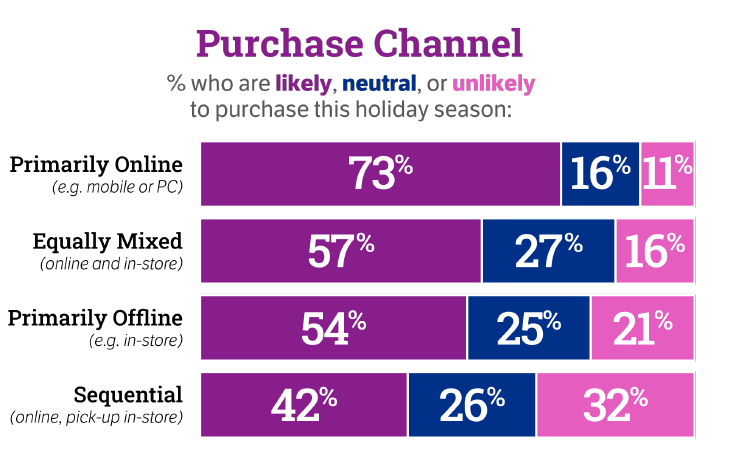
Source: Rakuten
Unsurprisingly, this is driven in large part due to health concerns about shopping in stores, with 40% of shoppers naming this as the reason behind their shift in 2020 buying behavior.
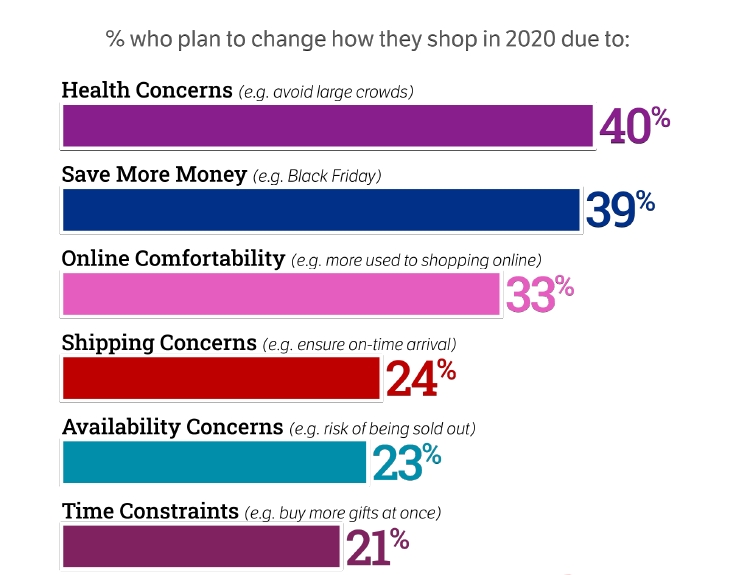
Source: Rakuten
At the same time, it’s interesting to see that many of the other reasons given are ecommerce benefits more generally.
With tools like the Honey browser extension, or myriad price comparison sites, it’s extremely easy to search for a great deal online and save some money. And at this point, many have realized the comfortability that comes with shopping from home in your pajamas.
So yes, lockdowns might drive consumers online out of necessity, and shoppers are concerned about their health this year. But ecommerce has been and continues to be popular because customers just really enjoy shopping online.
Online retail is being supercharged like never before
Over the past decade, we’ve seen online retail grow about 10-15% year-over-year in the U.S. and Europe.
Here’s what the growth looks like in the U.S., based on U.S. Department of Commerce data.
Source: Digital Commerce 360
And here’s how things looked in Western Europe in 2016 (future years were predictions, but you get the gist).
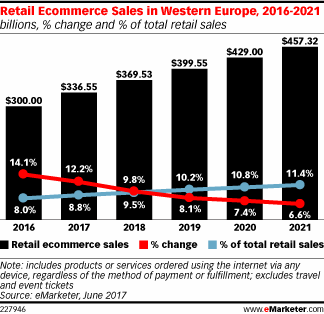
And then came 2020.
You’re likely familiar with this chart, showing how 10 years of growth took place in just 3 short months.
It took from about 2012 to 2019 to double ecommerce’s shares of sales, and then it doubled again in a few months of 2020.
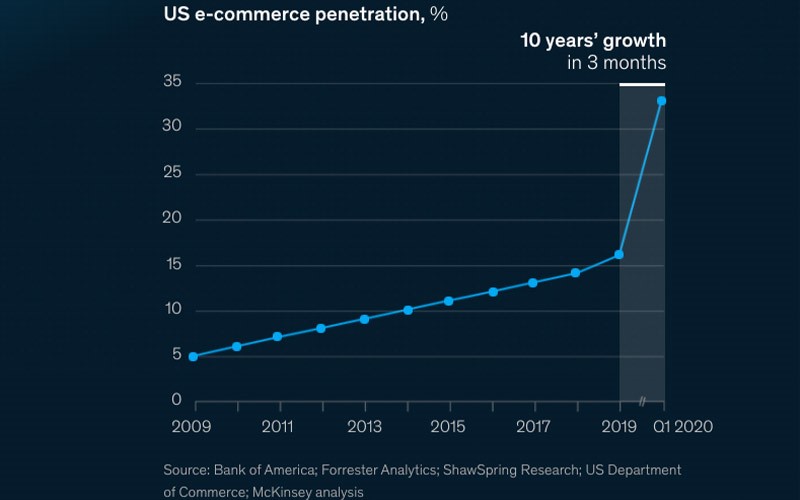
Source: McKinsey
We see examples from all over retail of this tremendous growth taking place in a compressed timeframe.
Take Dick’s Sporting Goods. In their Q2 SEC Filing, they wrote the following:
“Our eCommerce sales penetration to total net sales increased from approximately 9% in fiscal 2014 to approximately 16% in fiscal 2019.
Following our temporary store closures through the end of the first quarter of 2020, eCommerce sales grew 210%, with our new curbside contactless pickup accounting for over 40% of our total online business during this time period.
For the first fiscal quarter as a whole, eCommerce sales penetration was approximately 39%...”
Their ecommerce sales grew 210% during the quarter! And ecommerce more than doubled its share of total sales, neatly mirroring the overall trend in the McKinsey graph.
To sum up, online retail had been growing 10-15% year-over-year, and the pandemic is just supercharging that trend. As NYU Marketing professor Scott Galloway put it:
“Things won’t change as much as they will accelerate. While other crises reshaped the future, COVID-19 is just making the future happen faster.”
Scaling so fast is incredibly challenging
To produce something like Dick’s Sporting Good’s 210% increase in sales, so much has to scale. Your website, order fulfillment operations, supply chain, and customer support are all involved.
As the first step in the buying process, the website is uniquely challenging.
First, there’s the challenge of handling increased traffic on your website. We’ve talked elsewhere in the about how everything breaks at scale. Not all components of your website can scale equally. And each time you scale a bottleneck—your payment gateway or inventory system, for example—a new one pops up.
At a certain point, you can’t push more visitors into the purchasing flow without degrading their experience or worse, crashing.
RELATED: Are You Guilty of Falling for These 5 Ecommerce Myths?
This challenge impacts even the world’s biggest players. Amazon’s website crashed several times during its 2018 Prime Day sale. And it’s something we at Queue-it hear about all the time.
Here’s a comment from a recent call with a VP at a top 25 American retailer:
“We do a lot of engineering work just for that first couple minutes where we get that extreme load. It’s kind of crazy how much we invest in just making sure we can handle that.”
And here’s how Winkelstraat, one of our Dutch customers, describes it:
"The amount of online traffic that we handle during Black Friday can be 15-20 times higher than on a normal day. Because the traffic increase is difficult to estimate, it makes it very difficult to plan the scale up of your infrastructure."
Second, distribution of shoppers on your site matters.
Think of a supermarket: if everyone in the store is trying to pay at once, it is a vastly different experience than shoppers spread out evenly in the store, even if in both cases the total number of shoppers is the same. In the former, your website might crash. In the latter, it could be running smoothly. So controlling the flow, not just the total number of visitors on your website, is imperative.
RELATED: How to Avoid the Website Capacity Mistake Everyone Makes
Third, expanding your order fulfillment operations can impact your website too.
The Buy-Online-Pickup-In-Store (BOPIS) option has been critical in the recent spike in ecommerce activity. Recall that Dick’s Sporting Goods attributed 40% of their recent online sales to BOPIS. And Macy’s CFO has talked about how BOPIS orders are both more profitable and lead to larger average order value (AOV).
But this can add complexity to your website, where customers might need to reserve a timeslot to pick up their order—to say nothing of the work involved in transforming retail stores into fulfillment centers.
What strategies are retailers looking to for the 2020 holiday season?
1. Starting sales earlier
Christmas creep, a term first coined in the 1980s, is not new. It’s been at least a decade since stores started their first holiday season sales in September. And 2019’s shortened holiday season led to the earliest starts in recent memory.
Surprise surprise: 2020 is feeding into that trend even more, with major retailers rolling out their earliest-ever shopping promotions.
Check out this email a Queue-it team member received—in July!
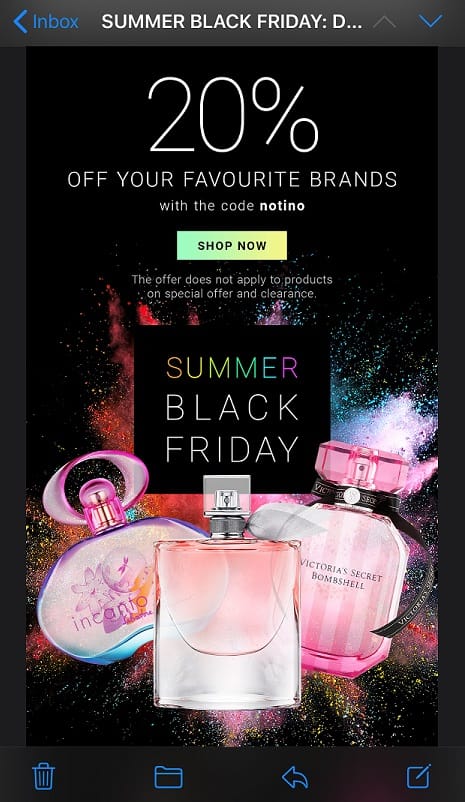
Is it a smart move for you, too? We think so.
Why? A few reasons.
Pay more now to pay less later
Spending more now to acquire customers means you can pay way less for their attention in the heat of the holiday season.
Where you might spend 2-3x in November or early December to acquire a customer via Google Ads, Google Shopping, Facebook, Instagram, or retargeting, focus getting them to convert now, even if into low average value order funnels. This puts shoppers into customer retention channels like email or SMS, which give you a more direct connection with consumers at orders of magnitude less.
Now, this doesn’t mean you have to label your September promotion with “September Black Friday” (despite all the grumbling about early holiday sales, most shoppers don’t mind them).
But you should be working now to optimize your spend later.
People will have less to spend later
There’s no question that some people will spend even if they don’t have cash flow to justify it.
Look no further than the upcoming PlayStation 5—rumored to bring with it a $500 price tag—for which Sony has boosted production by 50% to meet anticipated demand.
But, with unemployment high in the U.S., consumer confidence in the dumps, and federal unemployment benefits expiring, it’s uncertain how much consumers will have—or be willing—to spend come November and December.
Seasonality is already upended anyway
From the beginning of spring with bikinis purchased for a spring break that never happened, to the summer with its lack of travel and vacation, to back-to-school when most kids aren’t actually back in school—the pandemic has truly upended traditional retail seasonality.
Every retail season we depend on outside of the 2019 and 2020 holiday seasons has been upended in some way.
Think about it: the sweatpants boom happened in the middle of summer, where people are usually wearing shorts.
Durable goods, like weight training equipment, computer monitors, furniture, and appliances (🍞bread machines, anyone?) are getting a boost. None are really bound to seasonality.
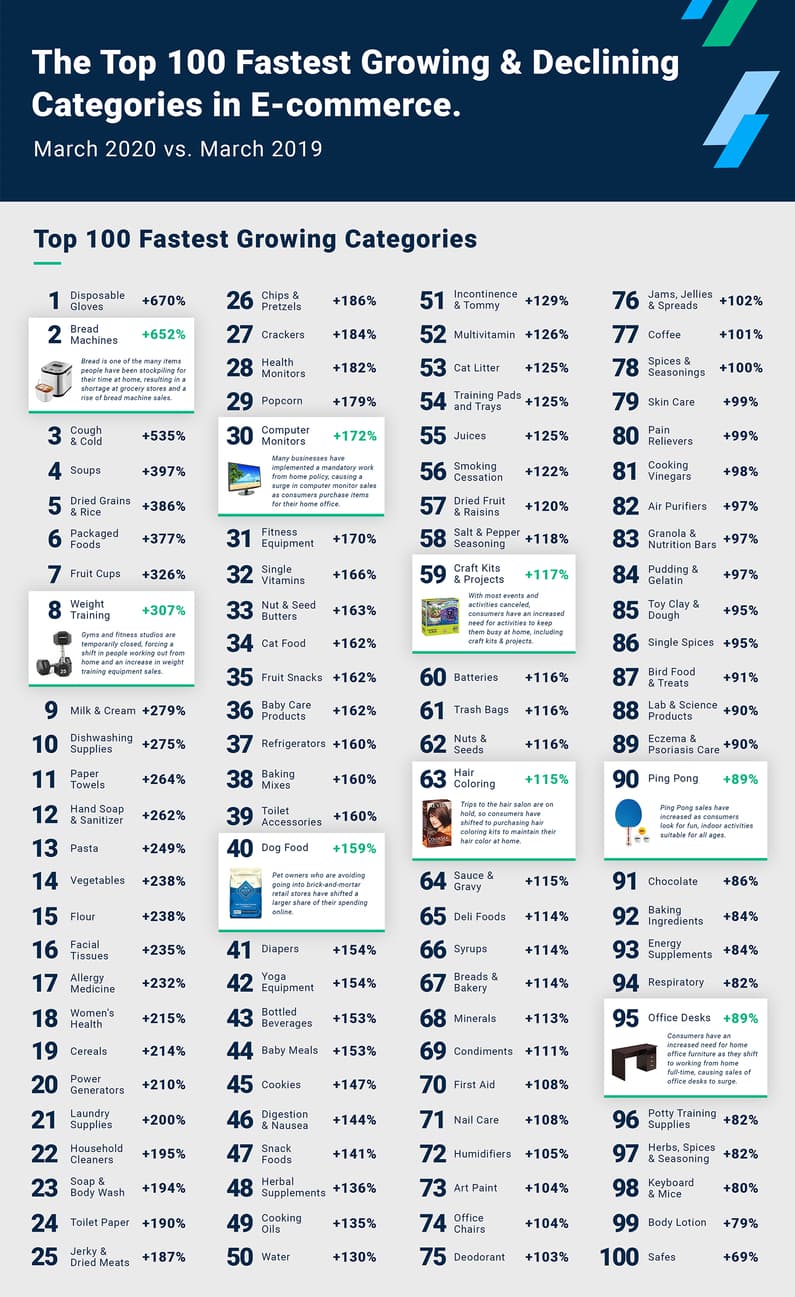
Source: Stackline
Our planning calendars have gone out the window in 2020, so there’s no need to stick to the old playbook of what should be selling now.
2. Using time-limited sales to drive hype
Nate Schenk, managing director of North American retail at Boston Consulting Group, recently told Business Insider:
“The irony is the biggest winners of Black Friday this year are likely to be the stores without a crowd and the trick is going to be replicating the excitement, traffic, and the spend without the actual traffic and crowds.”
If you’re the exclusive seller of a product, use it to your advantage. Look to drive hype with FOMO and exclusivity by launching sales on a specific date and time, with a specific timeframe in mind.
Many retailers are also planning on doing a successive series of product launches, instead of one monumental release. This can help in a few ways.
First, it helps you mitigate the risk of losing customer interest all in one day.
Second, it gives you several chances to stock up to meet the pent-up demand from customers.
And third, it helps take the load off your order fulfillment and shipping processes, which also helps hedge against any shipment delays.
Remember that you’ll need to manage the sudden surge in traffic to your site to run a smooth product launch.
And if you have limited-edition products, like a sneaker release, you should consider tools to prevent online shopping bots and ensure online fairness.
3. Leveraging BOPIS & curbside pickup
Recall from earlier that of Dick’s Sporting Goods huge increase in online sales, a full 40% came from buy-online-pickup-in-store. BOPIS and curbside pickup is a critical strategy for so many reasons.
First, customers always like to save on shipping, and they like getting their products ASAP. According to a 2018 study from Fisher, the top reasons digital shoppers prefer BOPIS over home delivery are high shipping cost (50%) and immediate need (50%).
And the BOPIS option helps secure sales that might otherwise not be made. The same survey found that 40% of consumers wouldn’t make a purchase if delivery takes more than 2 days.
Second, BOPIS is more profitable for retailers, too. Retailers save on shipping costs, which are often subsidized within the cost of the product to allow for free shipping. What’s more, BOPIS shoppers often buy more. 21% of online shoppers in a February 2020 survey reported making an additional purchase when picking up in store.
To take Macy’s as an example, CFO Paula Price cited “digital delivery expenses” as one of the retailer’s largest headwinds in early 2020, making the savings on BOPIS purchases all the more important. Price also reported that BOPIS shoppers buy about 25% more.
Third, contactless curbside pickup helps show you take customer’s health concerns seriously. As we saw earlier, the biggest reason shoppers plan on changing their 2020 buying behavior is due to health concerns. BOPIS keeps your customers feeling safe and confident when engaging with your business. And it keeps your employees safe, too.
At the same time, BOPIS brings with it added complexity.
There’s the logistical complexity of turning brick-and-mortar stores into order fulfillment centers. It’s more critical than ever that inventory systems are updated in real-time and this is reflected on your website and retail app.
And this selection process, especially if customers need to select a pickup time slot, add significant bottlenecks on your ecommerce site.
Paired with an increase in session duration as shoppers go through extra steps, your site might start failing earlier than you’d expect if you don’t have a way to manage traffic inflow.
4. Partnering strategically & broadening your product catalog
We believe the future of retail is what’s called the “peanut butter and jelly” approach. That is, marrying two or more congruent brands to create strategic partnerships and offer a suite of products that jives with your customers’ lifestyle.
Partnering strategically allows for a broadened product catalog but also collaboration in influencer awareness campaigns. If the fit is there, it will seem natural and just “make sense” for your customers.
This might sound aspirational for some brands, but if you look out 2-3 years, we expect many more brands to be here.
“The future of commerce is I believe in 3-5 years, every website is its own marketplace,” says Phillip Jackson. “Every retail brand is its own marketplace. D2C sites will be selling more than just what’s native in their catalog. They’ll be partnering and selling, either through dropship or owned inventory, products that they didn’t make but are collaboratively selling.”
“The future of commerce is I believe in 3-5 years, every website is its own marketplace,” says Phillip Jackson.
Todd Snyder, a New York-based menswear retailer, is a great example of the peanut butter and jelly approach. They’ve recently expanded their catalog to include everything from moisturizer to sunscreen, grooming products to luggage.
“When you’re looking at high-frequency purchase consumable products that fit the luxury lifestyle apparel brand like a Todd Snyder, the opportunities for partnership kind of become obvious,” says Jackson. “They’ll be partnering with other boutiques, small high-spend high-AOV consumable products, for instance in the skincare space. And that same customer is likely to buy from them anyway.”
Sometimes Todd Snyder’s is selling partner products (Aesop aftershave, for instance) that fit into the overall “modern man” luxury lifestyle.
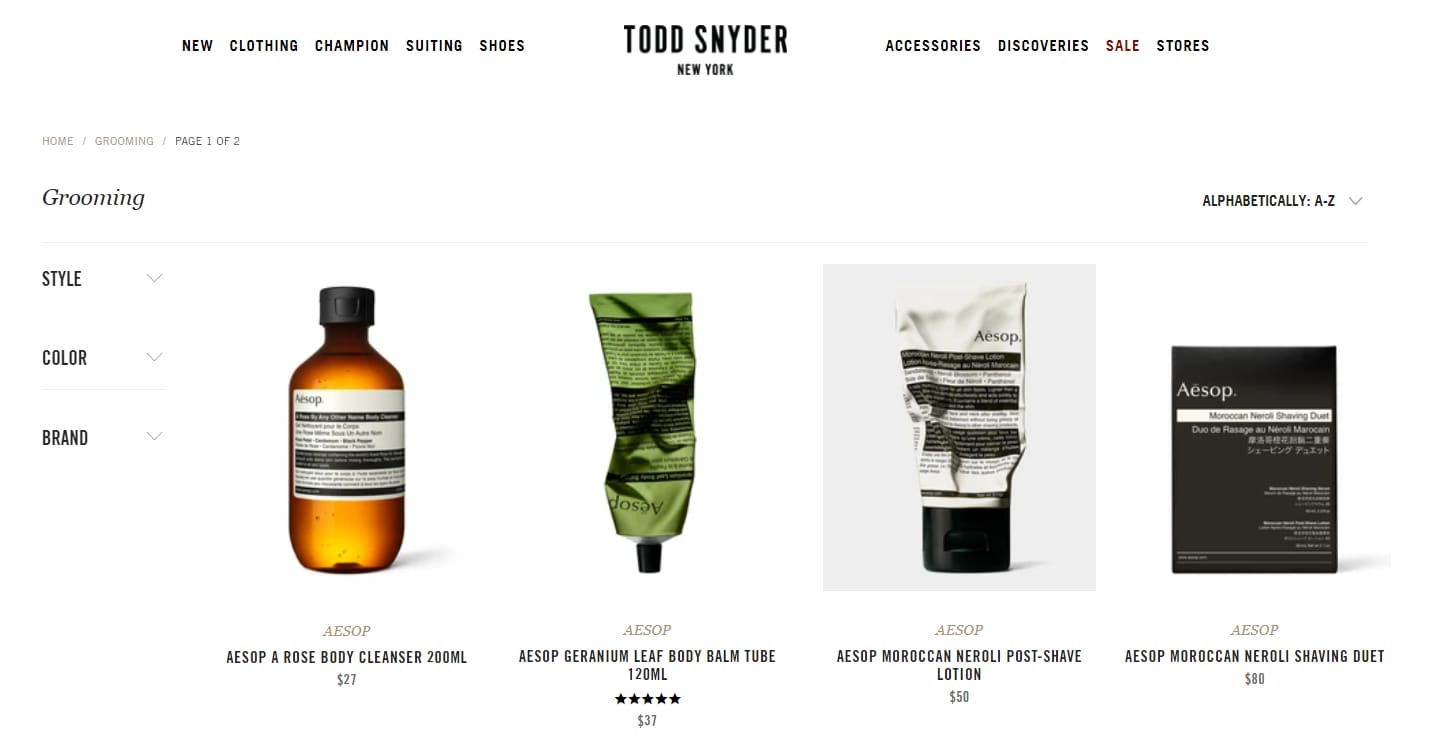
Other times, the retailer pairs up with partners for exclusive collections, as they’ve done with Champion sweats, Timex watches, or New Era hats.
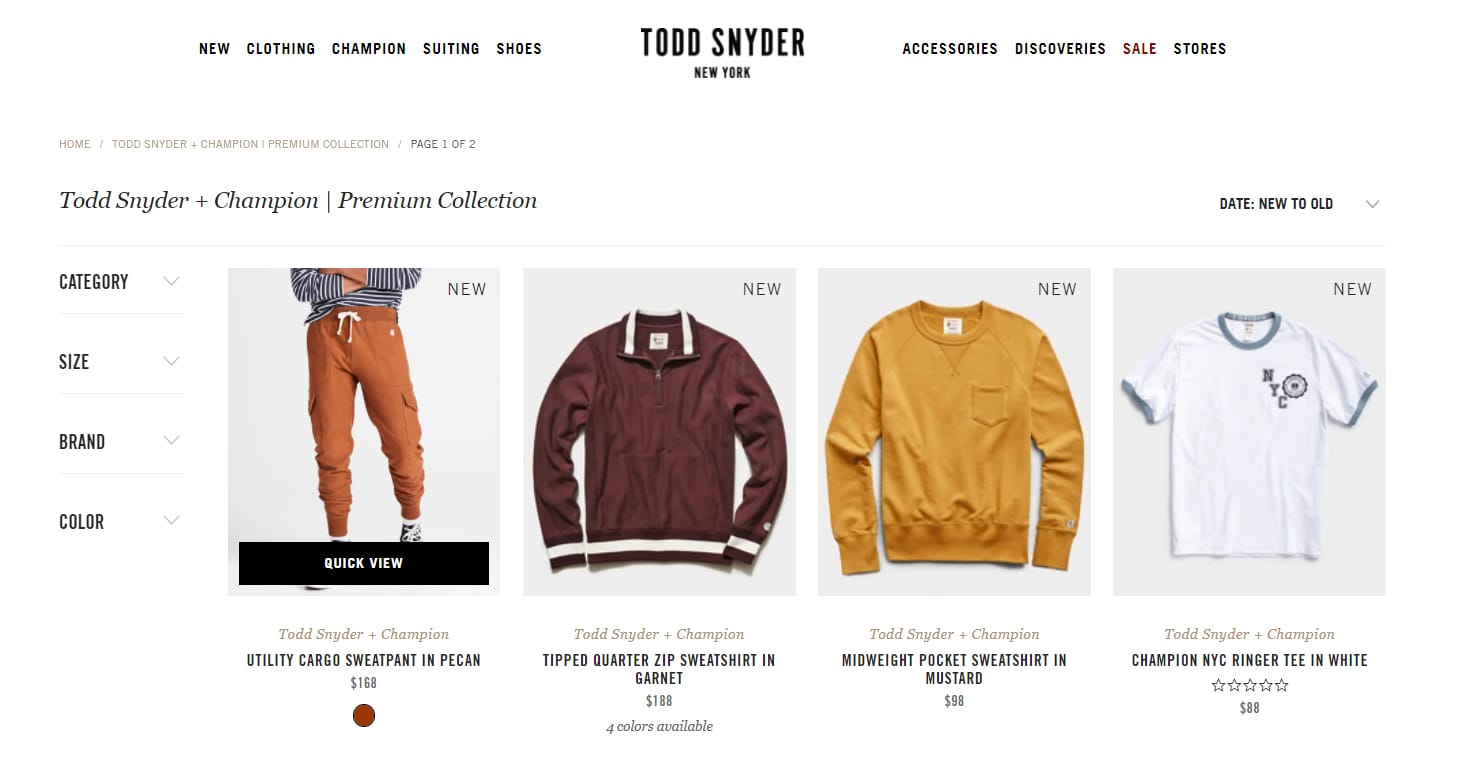
The fit is key, though, so do the research to make sure your partnerships will jive with your consumers. “When it fits, you’ll find natural brand ambassadors,” says Jackson.
This doesn’t have to mean influencer marketing in the sense of finding an Instagrammer with a massive following. It could be a flavor of affiliate marketing, where you give current customers discounts for bringing in their friends or family.
“Having more products that are more applicable to more people is a great way for you to broaden the net for them to evangelize your brand,” says Jackson.
How can you adapt your digital operations?
You have to be exceptionally adept at running a digital business to take advantage of the above strategies. Getting them right while handling increased online demand is a difficult balancing act for any online retailer.
The fact is, digital is your new flagship store. And you’ve got to get it right.
Your competitors know this. In a July 2020 report by Future Commerce, the biggest business spending shifts involve improvements to the retail website, the infrastructure that supports it, and the experience it delivers to your customers.
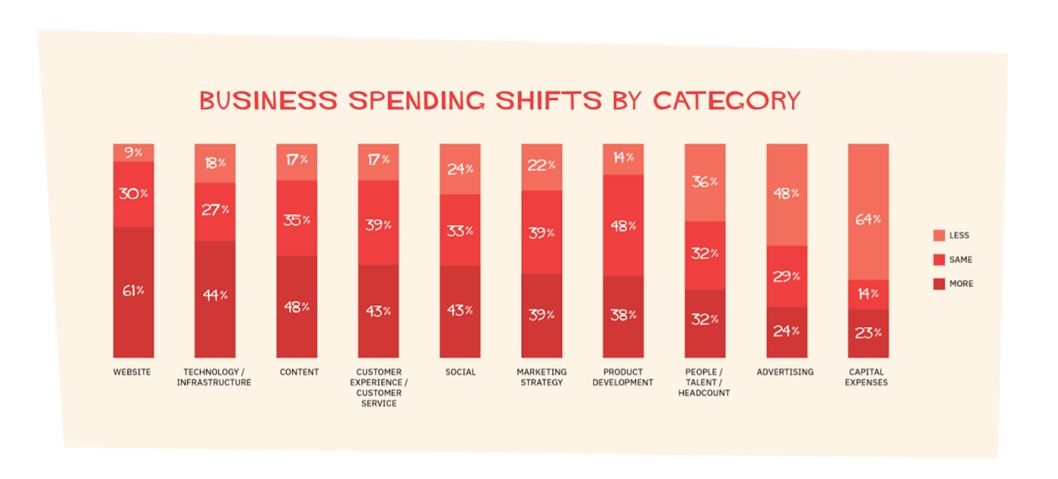
But it’s easy to say “we’re going to spend more on improving our website.”
What does that entail specifically?
Where should the spend be allocated?
What high-impact areas should you focus on?
These are important questions. That’s why we’ve put together 5 takeaways for you to prepare your digital operations and win this holiday season.

The overarching principle between customer experience (CX) and customer support (CS) is to ensure your customers get a smooth, positive experience on your site and feel connected to your brand—in short, that their interactions with your brand, across channels, are memorably great.
If you’re willing to fight for your customers, they’ll be more likely to evangelize your brand.
According to the Retail Rebirth report, 79% of consumers feel it’s important to have multiple ways to contact customer service. And 1 in 4 have avoided contacting customer service because it’s perceived as too much of a hassle.
The silver lining is the customers’ bar is still quite low, leaving the opportunity wide open for retailers to build a relationship of trust. More than ever, people want to feel like they have a connection and that they’re being heard.
Get creative with customer service methods—and staff them to ensure timely responses. Give customers the option to reach you via SMS, email, chat, phone, Facebook, and so on. And it’s not just customers—expect prospective buyers higher in the funnel to ask product questions in the comments of your Facebook ads.
Far too often, customer service teams are looked at as an expensive necessary evil. But done right a CX team could provide a net positive lift on revenue by retaining customers and responding to prospective ones at various touchpoints along their buying journey.

You’re trying to grow online sales and capture more of those old brick-and-mortar sales online. That means you’re going to increase traffic to your website and/or mobile app.
When looking at scaling your technology to meet these needs, autoscaling is a great first step. It’s cost effective and a crucial tool in increasing capacity.
But, scaling up require expertise. Big retailers have a dedicated team of DevOps engineers constantly monitoring server usage. Many retailers have to engage a 3rd party to help with scaling, either hosting company, or an enterprise vendor, to get to where they need to be.
And remember that scaling your servers doesn’t necessarily mean all parts of your website can scale equally well. The database is notoriously difficult to scale, as are inventory systems or payment gateways. In fact, payment gateways are often in the hands of 3rd parties, so that bottleneck remains despite scaling your own servers.
Invest the time and energy in scaling up your servers, for sure. But also be sure to consider which parts of your infrastructure are most and least likely to be helped by scaling up.
RELATED: How to Ensure Web Performance with Increased Ecommerce Traffic

Without a doubt, caching with a Content Delivery Network (CDN) is one of the most effective ways to improve scalability and build performance into your web application.
A CDN reduces the time for your content to load on your customer's browsers by geographically spreading your website content on servers across the globe.
You might be thinking: I already know this. CDNs aren’t anything new.
And that’s true. CDNs have been serving static content like pictures for years.
But now, many CDNs have expanded beyond caching for web performance. They cache dynamic content too, load balance traffic, protect against DDoS attacks and, with products like Cloudflare Workers, even provide a layer at which you can execute code.
So, check how you’re using your CDN, and you’re likely to find ways to tweak even more performance out of your ecommerce site.

You’ve likely spent years tinkering with and tailoring your site to make it just how you like. There’s always something to optimize, and you’ve added some nice bells and whistles along the way. But remember:
It’s always better to have a responsive, basic website than an unavailable, feature-rich one.
You can build your application with Ops Toggles so that performance intensive features are disabled when your system resources are low.
Prime targets for fancy “nice-to-have” features are an advanced search feature, or “Recommended for you” panels, which can be resource intensive.
Yes, the user experience will be degraded. But even the giants like Amazon do this, like when the site was overwhelmed by demand on Prime Day in 2018, and the company implemented a scaled-down “fallback” home page.
If Amazon uses feature toggling, you should too.
Another quick tip to tweak some extra performance out of your website is to use lazy loading. Basically, this means files like images don’t load all at once, but rather as a page loads. According to Google, visitors perceive sites that load this way as faster, even if the actual load times are comparatively slow.

As an ecommerce or IT manager under pressure to boost sales, you want to sell at your maximum capacity—without tipping your site over.
While there are several ways to manage online traffic—scale up servers, build performance into your website, coordinate marketing campaigns—none give granular control over precisely how many visitors are flowing through your site at a given time.
That’s where a virtual waiting room comes into play. When online visitors exceed your capacity, they are redirected to a customizable waiting room off of your infrastructure and then throttled back to your website or app in a controlled first-come, first-served order.
Crucially, you can place this at any step in the buying journey.
Having a big launch? Protect the landing page.
Want shoppers to browse your products, but your payment gateway has a limit to how many orders it can process per minute? Implement right before checkout.
If traffic remains below thresholds you configure, visitors will never know the virtual waiting room is in place. So, a virtual waiting room serves as a 24/7 safety net to ensure your sales run successfully, no matter the demand.
Summing up
The 2020 holiday season is going to look different than any other one we’ve seen. The things that work for you will be different to what works for others.
What you’ll gain most from is applying the scientific method, generating hypotheses and testing them. The sooner you do that, the sooner you’ll connect with your customers and figure out what’s working—and what’s not.
The brands that will be most resilient are the ones that aren’t waiting until the end of the year to get experimental. They’re doing it right now.
As the adage goes, this too shall pass. Being nimble and agile is your most valuable asset—both now and long into the future.
If you’re looking for ideas to start testing, we’ve given you several here.
- Try starting sales earlier and putting low AOV customers into cheaper retention funnels
- Use exclusivity to drive hype
- Look for strategic partnerships with brands that fit your lifestyle
- Test out BOPIS
- Invest in new customer support models
- Add feature toggling to your website for performance-intensive features
- Manage traffic using a virtual waiting room
Just like one marketing campaign won’t make or break your business, nor will one failed experiment.
But your ability to learn from what’s working, adapt that, and fold it into your business will change you forever.
